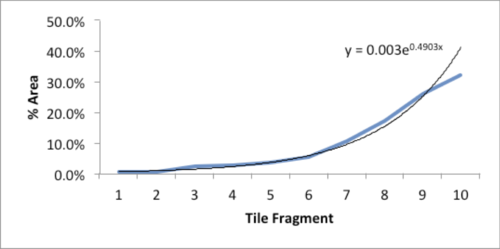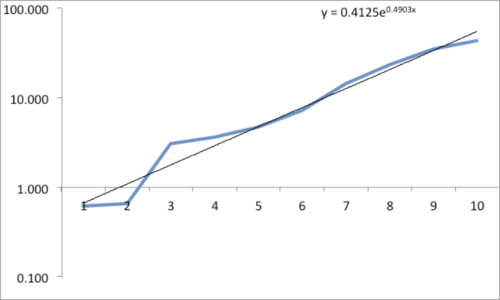|
|
| Line 1: |
Line 1: |
| ==MicroMorts==
| |
| Margaret Cibes sent a link to the following:
| |
|
| |
| [http://online.wsj.com/articles/risk-is-never-a-strict-numbers-game-1405728892 Risk is never a strict numbers game]<br>
| |
| by Michael Blastland and David Spiegelhalter, ''Wall Street Journal'', 18 July 2014
| |
|
| |
| Noting that people are notoriously bad at weighing risks (e.g., in preferring driving to flying), this essay explains the use ''MicroMorts'' to simplify comparisons. This unit of measure, representing deaths per million, is credited to Stanford professor Ronald Howard.
| |
|
| |
| David Spiegelhalter, one of the article's authors, is member of the [http://understandinguncertainty.org Understanding Uncertainty] project, based at the Statistical Laboratory in the University of Cambridge. In a blog post there, entitled [http://understandinguncertainty.org/node/1302 Micromorts, horses and ecstasy], he analyzes a claim that [http://www.telegraph.co.uk/news/uknews/law-and-order/4537874/Ecstasy-no-more-dangerous-than-horse-riding.html horse riding and using the drug ecstasy have comparable risks]. Indeed, as measured in micromorts, this appears to be plausible, but Spiegelhalter notes that the issues at play go beyond crunching the numbers.
| |
|
| |
| For more on micromorts, see
| |
|
| |
| :[http://plus.maths.org/content/os/issue55/features/risk/index Understanding uncertainty: Small but lethal]<br>
| |
| :by David Spiegelhalter and Mike Pearson, ''Plus'' magazine, 12 July 2010
| |
|
| |
|
| ==Accidental insights== | | ==Accidental insights== |
| Line 64: |
Line 50: |
|
| |
|
|
| |
|
|
| |
| Submitted by Bill Peterson
| |
|
| |
| ==Cautions on polls==
| |
| [http://www.nytimes.com/2014/07/10/upshot/how-to-read-the-polls-in-this-years-midterms.html?_r=0 How to read the polls in this year's midterms]<br>
| |
| by Nate Cohn, "The Upshot" blog, ''New York Times'', 10 July 2014
| |
|
| |
| According to Cohn:
| |
| <blockquote>
| |
| So far this year, 65 percent of polls in Senate battlegrounds have been sponsored or conducted by partisan organizations, and an additional 10 percent were conducted by Rasmussen, an ostensibly nonpartisan firm that leans conservative and has a poor record.
| |
| </blockquote>
| |
| He follows up with a detailed discussion of the polling situation in five states where a sitting Democratic senator faces a strong challenge.
| |
|
| |
| In forecass of the 2012 presidential election, models based on aggregates of polling results [http://test.causeweb.org/wiki/chance/index.php/Chance_News_89#Election_wrap-up:_Statisticians_vs._pundits famously outperformed political pundits]. Cohn wonders whether such models can be as successful in the current climate.
| |
|
| |
| A different spin on polls was given in an op/ed piece following Eric Cantor's primary loss in the spring:
| |
|
| |
| [http://www.nytimes.com/2014/06/12/opinion/republicans-couldnt-predict-eric-cantors-loss.html?hp&rref=opinion Why polling fails: Republicans couldn’t predict Eric Cantor’s loss]<br>
| |
| by Frank Luntz, ''New York Times'', 11 June 2014
| |
|
| |
| Luntz (whose firm Luntz Global does polling and communications work) has some curious comments on polls. He writes:
| |
| <blockquote>
| |
| The simple truth remains that one in 20 polls — by the simple rules of math — misses the mark. That’s why there is that small but seemingly invisible “health warning” at the end of every poll, about the 95 percent confidence level. Even if every scientific approach is applied perfectly, 5 percent of all polls will end up outside the margin of error. They are electoral exercises in Russian roulette. Live by the poll; die by the poll.
| |
| </blockquote>
| |
| His recommendation is more reliance on face-to-face interview rather than impersonal polling:
| |
| <blockquote>
| |
| Ironically enough in this wired-up age, the face to face remains a fundamental component of exploring voter mind-set. It is only by being in a room with voters that you can truly get the answer you need. It is about asking the right questions of the right people, and demanding honest answers.
| |
| </blockquote>
| |
|
| |
| '''Discussion'''
| |
|
| |
| 1. If people's responses to polls don't correspond to their actual voting behavior, what kind of error is this? Is it covered by the 5 percent warning?
| |
|
| |
| 2. How do you think Luntz proposes to get the "right people" in his sample?
| |
|
| |
|
| Submitted by Bill Peterson | | Submitted by Bill Peterson |
Accidental insights
My collective understanding of Power Laws would fit beneath the shallow end of the long tail. Curiosity, however, easily fills the fat end. I long have been intrigued by the concept and the surprisingly common appearance of power laws in varied natural, social and organizational dynamics. But, am I just seeing a statistical novelty or is there meaning and utility in Power Law relationships? Here’s a case in point.
While carrying a pair of 10 lb. hand weights one, by chance, slipped from my grasp and fell onto a piece of ceramic tile I had left on the carpeted floor. The fractured tile was inconsequential, meant for the trash.

As I stared, slightly annoyed, at the mess, a favorite maxim of the Greek philosopher, Epictetus, came to mind: “On the occasion of every accident that befalls you, turn to yourself and ask what power you have to put it to use.” Could this array of large and small polygons form a Power Law? With curiosity piqued, I collected all the fragments and measured the area of each piece.
| Piece |
Sq. Inches |
% of Total
|
| 1 |
43.25 |
31.9%
|
| 2 |
35.25 |
26.0%
|
| 3 |
23.25 |
17.2%
|
| 4 |
14.10 |
10.4%
|
| 5 |
7.10 |
5.2%
|
| 6 |
4.70 |
3.5%
|
| 7 |
3.60 |
2.7%
|
| 8 |
3.03 |
2.2%
|
| 9 |
0.66 |
0.5%
|
| 10 |
0.61 |
0.5%
|

The data and plot look like a Power Law distribution. The first plot is an exponential fit of percent total area. The second plot is same data on a log normal format. Clue: Ok, data fits a straight line. I found myself again in the shallow end of the knowledge curve. Does the data reflect a Power Law or something else, and if it does what does it reflect? What insights can I gain from this accident? Favorite maxims of Epictetus and Pasteur echoed in my head:
“On the occasion of every accident that befalls you, remember to turn to yourself and inquire what power you have to turn it to use” and “Chance favors only the prepared mind.”

My “prepared” mind searched for answers, leading me down varied learning paths. Tapping the power of networks, I dropped a note to Chance News editor Bill Peterson. His quick web search surfaced a story from Nature News on research by Hans Herrmann, et. al. Shattered eggs reveal secrets of explosions. As described there, researchers have found power-law relationships for the fragments produced by shattering a pane of glass or breaking a solid object, such as a stone. Seems there is a science underpinning how things break and explode; potentially useful in Forensic reconstructions.
Bill also provided a link to a vignette from CRAN describing a maximum likelihood procedure for fitting a Power Law relationship. I am now learning my way through that.
Submitted by William Montante
Reproducibility
When studies are wrong: A coda
by George Johnson, New York Times, 7 March 2014
Submitted by Bill Peterson


